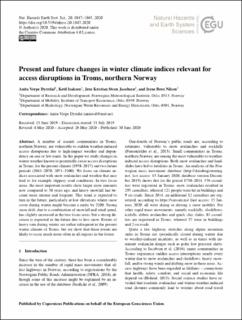Present and future changes in winter climate indices relevant for access disruptions in Troms, northern Norway
Journal article
Permanent lenke
https://hdl.handle.net/11250/2838824Utgivelsesdato
2020Metadata
Vis full innførselSamlinger
Originalversjon
https://doi.org/10.5194/nhess-20-1847-2020Sammendrag
A number of seaside communities in Troms, northern Norway, are vulnerable to sudden weather-induced access disruptions due to high-impact weather and dependency on one or few roads. In this paper we study changes in winter weather known to potentially cause access disruptions in Troms, for the present climate (1958–2017) and two future periods (2041–2070; 2071–2100). We focus on climate indices associated with snow avalanches and weather that may lead to for example slippery road conditions. In two focus areas, the most important results show larger snow amounts now compared to 50 years ago, and heavy snowfall has become more intense and frequent. This trend is expected to turn in the future, particularly at low elevations where snow cover during winter might become a rarity by 2100. Strong snow drift, due to a combination of snowfall and wind speed, has slightly increased in the two focus areas, but a strong decrease is expected in the future due to less snow. Events of heavy rain during winter are rather infrequent in the present winter climate of Troms, but we show that these events are likely to occur much more often in all regions in the future.

